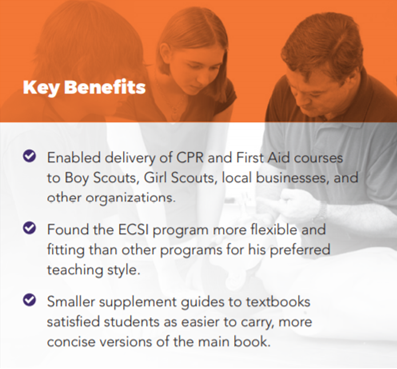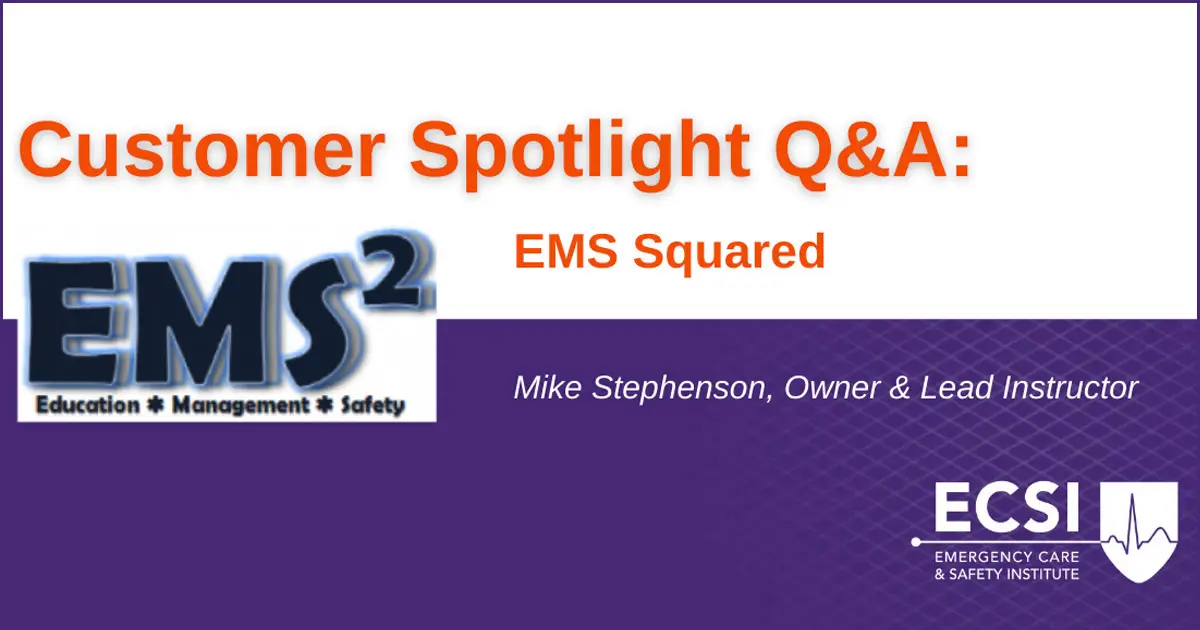As part of the ECSI Customer Spotlight series, we had the chance to speak with Mike Stephenson, Owner & Lead Instructor of EMS Squared. In this Spotlight, Stephenson shares his experience using ECSI products in his CPR, AED, and first aid classes, including wilderness first aid.
Overview
Mike Stephenson is a retired Battalion Chief from the Austin (TX) Fire Department. Since receiving numerous requests from friends and acquaintances for CPR and First Aid training after retirement, Mike decided to start his own side business, EMS Squared, to deliver classes to the nearby community. His business has been active for 10 years, and while his main customer base is the Boy and Girl Scouts of America, he also delivers training to local businesses, including doctor and dentist offices, and other organizations as requested.
What initially led you to considering ECSI for your classes?
 I had previously built out my own first aid course with a friend of mine who was a nurse. Back when standardized first aid courses started becoming popular, I figured it was best to explore and adopt one for my own classes to ensure I was delivering lessons that met the latest standards. After exploring my options, I felt ECSI was the best fit for my classes. For example, I really like how there’s the spiral bound manual that I can get to accompany the main textbook. Most of my students aren’t going to keep a 300+ page textbook on them, but they will keep a small manual with them that they can easily take “on the go” if the need for it ever arises.
I had previously built out my own first aid course with a friend of mine who was a nurse. Back when standardized first aid courses started becoming popular, I figured it was best to explore and adopt one for my own classes to ensure I was delivering lessons that met the latest standards. After exploring my options, I felt ECSI was the best fit for my classes. For example, I really like how there’s the spiral bound manual that I can get to accompany the main textbook. Most of my students aren’t going to keep a 300+ page textbook on them, but they will keep a small manual with them that they can easily take “on the go” if the need for it ever arises.
What sets ECSI training apart from the competition?
The thing I enjoy the most about ECSI is that the program is flexible. I get the instructor materials from ECSI, and I can model my class and delivery of the material however I feel is best suited for the course I’m teaching. Some other programs are very rigid in how they want you to deliver your course, which doesn’t suit my teaching style. For example, I delivered a class last weekend to a group of off-road mountain biking coaches that was built on the Wilderness First Aid model. I’m not going to deliver first aid courses to them the same way I would to the Boy Scouts or to corporate offices, the latter of which typically have no use for wilderness first aid. With ECSI providing the basic materials, I can tweak the curriculum to teach each group of students what they need to know.
What do you like the most about the Wilderness First Aid training program? Would you recommend it to others in scouting?
I would recommend it. The guidelines are up to date, and the program itself is very flexible in how you can deliver the material. It makes it very easy to distinguish between standard first aid, “street medicine” (predicated on transporting someone to a hospital in 10-15 minutes), and wilderness first aid, which explores possibilities like when you may have to camp out with an injured person overnight before being able to seek care the next day. I’ve been satisfied with the material.
How do you feel ECSI has aided in the work you do? Have any of your students ever had to make a save in real life?
While I don’t have any stories of student saves, I’m grateful for the fact that I don’t. I always joke with my students that “I hope the money you spent here goes to waste” because I hope they never have to use the stuff I’m teaching them in the real world. However, I’ve gotten positive feedback from students, and they are generally very happy with my courses and the ECSI material.
What advice would you give existing ECSI Education Centers and Instructors on how to be the most effective in providing emergency care training to their communities?
I’d say listen to your students, ask them what they want from the classes, and tailor the classes to fit those wants and needs. For example, when I’ve delivered training to doctor and dentist offices, they want to do it before their workday starts. This means I’m delivering CPR re-certification at 5 AM to my dentist’s office because they don’t want it to interrupt their day-to-day business operations. If it’s what they want, I do my best to try and meet those needs.
I also deliver my training wherever the organization I’m working with wants to do it. I tell them that I’ll bring the materials; all they need to do is provide a space for me to deliver the training. The more flexible you can be in how, when, and where you deliver emergency care training, the more receptive people will be to your program.

During the COVID-19 pandemic, have you found any unique ways to continue your training while keeping your students safe?
Obviously, we’re using masks and keeping our distance where we can. A lot of my classes have family pairs, such as fathers and sons or husbands and wives, taking the class together, so I try to keep them paired with each other whenever there’s a demonstration or a hands-on exercise in pairs. Also, we do classes outdoors as much as we can, which is a benefit of teaching in Texas!
Some groups that I teach also meet on a weekly basis, so if there was an outbreak, we’d have time to identify it and isolate as needed. Luckily, we’ve had no trouble so far
Any closing words you’d like to share with people considering using ECSI for emergency care training?
I recommend reading all the materials so you understand what’s in the textbook and manuals. Don’t feel like you’re locked into going chapter-by-chapter; you can structure the class to utilize your personal experience and tweak the delivery of material as you feel is necessary.
Lastly, have fun with it. While the material is serious and people are looking at you to be the expert, that doesn’t mean you can’t make the training fun.
For more information about training with ECSI, please visit our website today.
